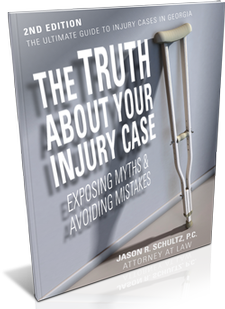What are the seven intersection hazards? What makes them so dangerous and how can you avoid them?
1) T for Traffic Blocking
Traffic blocking, also known as “blocking the box,” is a huge danger in our city. The “box” refers to the area inside the intersection.
When a driver pulls into an intersection without enough time to clear the intersection before their light turns red (e.g., if traffic is backed up on the other side of the intersection), s/he has blocked the box. The driver is now stuck in the intersection, not able to completely clear the intersection, and blocking other traffic once the light changes.
If a driver is not paying close enough attention, s/he might slam right into the car blocking the box. The driver might also be involved in a rear-end accident if s/he needs to stop quickly to avoid hitting the car.
Peachtree City has a safety video promoting the city’s safety campaign, called “Don’t Block the Box.” In the video, an officer urges drivers not to enter an intersection if they will not be able to clear the intersection before their light changes.
Blocking the box is especially problematic during the holidays, when there is more traffic than usual.
To avoid blocking the box, ensure you have enough space on the other side of the intersection to move into. If you see a line of brake lights on the other side of the intersection, wait on your side at the light. Only move across the intersection when you know you have enough room on the other side.
2) R for Running Red Lights
Running red lights results in many fatalities every year. There were 709 deaths and approximately 126,000 injuries in 2014 caused by running red lights. While this number is high, it is much lower than it could be because of the presence of red light cameras.
Unfortunately, many cities in the U.S. have decided to get rid of their red light cameras because of pushback from citizens. Georgia does use red light cameras despite some resistance from residents.
To avoid running red lights, do not try to beat yellow lights. If you think the light will turn red while you are going through the intersection, do not speed up to beat it. Slow down, stop, and wait until the next light cycle.
To avoid being hit by a driver running a red light, wait a second until you are sure all traffic has stopped before heading into the intersection.
3) O for On Foot
Intersections should be safe spaces for pedestrians; after all, pedestrians have crosswalks all around the intersection to allow them to cross safely.
However, problems arise when pedestrians ignore traffic and crossing signals and just walk out into the street. This puts the pedestrian in danger of being struck by a passing vehicle. It also puts the motorists in danger of either hitting a pedestrian or hitting another vehicle when swerving to avoid the pedestrian.
Motorists also share much of the blame for pedestrian accidents. Oftentimes, motorists (usually those turning left or right) ignore pedestrian crossing signals and turn in front of pedestrians or while pedestrians are still in the crosswalk.
To avoid a pedestrian accident, always follow traffic lights and crossing signals.
4) U for U-turns
When a motorist makes a U-turn at an intersection, it can result in a collision. This can happen in several ways.
- The driver making the U-turn can fail to see oncoming traffic.
- The driver can crash into vehicles that are turning right.
- The driver can hit pedestrians in the crosswalk while making a U-turn.
To avoid a U-turn collision, always check for traffic (from every direction) multiple times before making the U-turn.
5) B for Bicyclists
Drivers need to be especially vigilant around bicyclists, as it can be difficult to see them at intersections.
If a driver is turning right at the intersection, she can pull into the path of a bicyclist who was riding alongside her. Another collision scenario can happen when a driver tries to get through an intersection before a bicyclist, even though the bicyclist has the light and the right of way.
If a bicyclist is using a cell phone or listening to music, he might ride directly into the path of a vehicle that has the right of way.
To avoid bicycle accidents at intersections, always be vigilant and check your blind spots twice. Bicyclists should never ride with both headphones in as this can make it impossible to hear cars or sirens.
6) L for Left Turns
Making a left turn can be risky in many situations, but especially in an intersection.
A left-turning vehicle could collide with a pedestrian or bicyclist crossing the street, with oncoming traffic, or with a driver turning right on red. In many situations, the left-turning driver is at fault when there is a collision.
You can avoid a left-turn accident by always checking twice for traffic. If you cannot see traffic (e.g., if there is a car in the opposite turn lane blocking your view), wait to make your turn.
Pedestrians and bicyclists can help avoid collisions by also crossing when they have a walk signal, and, even then, making sure that drivers are obeying those signals.
7) E for Emergency Vehicles
Seldom thought of as such, emergency vehicles are indeed a hazard to avoid when driving through an intersection. You might have the green light, and think you are driving legally, but out of nowhere, an emergency vehicle hits you in the middle of the intersection.
While standard operating procedures require all emergency vehicles to stop at intersections if the driver cannot see all traffic, not all drivers do so.
To avoid accidents with emergency vehicles, keep your music at a reasonable volume, keep distractions to a minimum, and always scan the intersection for lights and sirens.


